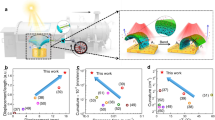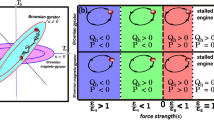Abstract
Heat engines provide most of our mechanical power and are essential for transportation on the macroscopic scale. However, although significant progress has been made in the miniaturization of electrostatic engines, it has proved difficult to reduce the size of liquid- or gas-driven heat engines below 107 μm3. Here we demonstrate that a crystalline silicon structure operates as a cyclic piezoresistive heat engine when it is driven by a sufficiently high d.c. current. A 0.34 μm3 engine beam draws heat from the d.c. current using the piezoresistive effect and converts it into mechanical work by expansion and contraction at different temperatures. This mechanical power drives a silicon resonator of 1.1×103 μm3 into sustained oscillation. Even below the oscillation threshold the engine beam continues to amplify the resonator’s Brownian motion. When its thermodynamic cycle is inverted, the structure is shown to reduce these thermal fluctuations, therefore operating as a refrigerator.
This is a preview of subscription content, access via your institution
Access options
Subscribe to this journal
Receive 12 print issues and online access
$209.00 per year
only $17.42 per issue
Buy this article
- Purchase on Springer Link
- Instant access to full article PDF
Prices may be subject to local taxes which are calculated during checkout





Similar content being viewed by others
References
Epstein, A. H. Millimeter-scale, micro-electro-mechanical systems gas turbine engines. J. Eng. Gas Turbines Power 126, 205–226 (2004).
Jacobson, S. A. & Epstein, A. H. Int. Symp. Micro-Mech. Eng. (ISMME) pK18 (2003).
Spadaccini, C. M. & Waitz, I. A. Comprehensive Microsystems Ch. 3.15 (Elsevier, 2008).
Peterson, R. B. Size limits for regenerative heat engines. Nanoscale Microscale Thermophys. Eng. 2, 121–131 (1998).
Wilfinger, R. J., Bardell, P. H. & Chhabra, D. S. The resonistor: A frequency selective device utilizing the mechanical resonance of a silicon substrate. IBM J. Res. Dev. 12, 113–117 (1968).
Elwenspoek, M. et al. Transduction mechanisms and their applications in micromechanical devices. Proc. IEEE MEMS 126–132 (1989).
Lammerink, T., Elwenspoek, M. & Fluitman, J. Frequency dependence of thermal excitation of micromechanical resonators. Sens. Actuat. A 25–27, 685–689 (1991).
Guckel, H. et al. Thermo-magnetic metal flexure actuators. IEEE Solid-State Sens. Actuat. Workshop 5, 73–75 (1992).
Reichenbach, R. B., Zalalutdinov, M., Parpia, J. M. & Craighead, H. G. RF MEMS oscillator with integrated resistive transduction. IEEE Elect. Dev. L. 27, 805–807 (2006).
Seo, J. H. & Brand, O. High Q-factor in-plane-mode resonant microsensor platform for gaseous/liquid environment. J. MEMS 17, 483–493 (2008).
Cohadon, P., Heidmann, A. & Pinard, M. Cooling of a mirror by radiation pressure. Phys. Rev. Lett. 83, 3174–3177 (1999).
Metzger, C. H. & Karrai, K. Cavity cooling of a microlever. Nature 432, 1002–1005 (2004).
Arcizet, O., Cohadon, P-F., Briant, T., Pinard, M. & Heidmann, A. Radiation-pressure cooling and optomechanical instability of a micromirror. Nature 444, 71–74 (2006).
Kleckner, D. & Bouwmeester, D. Sub-kelvin optical cooling of a micromechanical resonator. Nature 444, 75–78 (2006).
Schliesser, A., Del’Haye, P., Nooshi, N., Vahala, K. J. & Kippenberg, T. J. Radiation pressure cooling of a micromechanical oscillator using dynamical backaction. Phys. Rev. Lett. 97, 243905 (2006).
Brown, K. R. et al. Passive cooling of a micromechanical oscillator with a resonant electric circuit. Phys. Rev. Lett. 99, 137205 (2007).
Metzger, C., Favero, I., Ortlieb, A. & Karrai, K. Optical self cooling of a deformable Fabry-Perot cavity in the classical limit. Phys. Rev. B 78, 035309 (2008).
Teufel, J., Donner, T., Castellanos-Beltran, M. A., Harlow, J. & Lehnert, W. Nanomechanical motion measured with an imprecision below that at the standard quantum limit. Nature Nanotech. 4, 820–823 (2009).
Feynman, R. P., Leighton, R. B. & Sands, M. The Feynman Lectures on Physics Vol. I, Ch. 46 (Addison-Wesley, 1963).
Spadaccini, C. et al. Proc. ASME/IGTI Turbo Expo GT–2002–30082 (2002).
Köser, H. & Lang, J. Modelling a high power density MEMS magnetic induction machine. Proc. MSM Nanotech. (2001).
Fennimore, A. M. et al. Rotational actuators based on carbon nanotubes. Nature 424, 408–410 (2003).
Fan, D. L., Zhu, F. Q., Cammarata, R. C. & Chien, C. L. Controllable high-speed rotation of nanowires. Phys. Rev. Lett. 94, 247208 (2005).
Ayari, A. et al. Self-oscillations in field emission nanowire mechanical resonators: A nanometric dc–ac conversion. Nano Lett. 7, 2252–2257 (2007).
Weldon, J. A., Alemán, B., Sussman, A., Gannett, W. & Zettl, A. K. Sustained mechanical self-oscillations in carbon nanotubes. Nano Lett. 10, 1728–1733 (2010).
Ebefors, T. & Stemme, G. The MEMS Handbook: MEMS Applications (CRC Press, 2006) (Ch. Microrobotics).
Burg, T. P. et al. Weighing of biomolecules, single cells and single nanoparticles in fluid. Nature 446, 1066–1069 (2007).
Bullis, W. M., Brewer, F. H., Kolstad, C. D. & Swartzendruber, L. J. Temperature coefficient of resistivity of silicon and germanium near room temperature. Solid-State Electron. 11, 639–646 (1968).
Acknowledgements
We thank J. J. M. Ruigrok, C. S. Vaucher, K. Reimann, R. Woltjer and E. P. A. M. Bakkers for discussions and suggestions and thank J. v. Wingerden for his assistance with the scanning electron microscope measurements.
Author information
Authors and Affiliations
Contributions
K.L.P., P.G.S., J.T.M.v.B. and M.J.G. invented and designed the device. P.G.S., K.L.P., M.J.G. and C.v.d.A. carried out the experiments. P.G.S. developed the theory, analysed the experiments and wrote the Article. J.T.M.v.B., G.E.J.K. and G.J.A.M.B. developed the process technology and manufactured the device.
Corresponding author
Ethics declarations
Competing interests
The authors declare no competing financial interests.
Supplementary information
Supplementary Information
Supplementary Information (PDF 314 kb)
Supplementary Movie
Supplementary Movie 1 (MOV 290 kb)
Rights and permissions
About this article
Cite this article
Steeneken, P., Le Phan, K., Goossens, M. et al. Piezoresistive heat engine and refrigerator. Nature Phys 7, 354–359 (2011). https://doi.org/10.1038/nphys1871
Received:
Accepted:
Published:
Issue Date:
DOI: https://doi.org/10.1038/nphys1871
This article is cited by
-
Overcoming power-efficiency tradeoff in a micro heat engine by engineered system-bath interactions
Nature Communications (2023)
-
MEMS thermal-piezoresistive resonators, thermal-piezoresistive oscillators, and sensors
Microsystem Technologies (2023)
-
Quality factor control of mechanical resonators using variable phononic bandgap on periodic microstructures
Scientific Reports (2022)
-
Biomass conversion of agricultural waste residues for different applications: a comprehensive review
Environmental Science and Pollution Research (2022)
-
Rolling membrane powered by low-temperature steam as a new approach to generate mechanical energy
Scientific Reports (2020)



